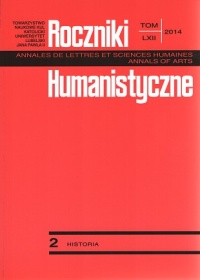Wzorce świętości w Fortecy duchownej Królestwa Polskiego Piotra Hiacynta Pruszcza
Abstrakt
Od końca XVI wieku w Polsce i Europie zaczęto tworzyć liczne katalogi i zbiory żywotów świętych, które miały propagować kult rodzimych świętych. Piotr Hiacynt Pruszcz w Fortecy duchownej Królestwa Polskiego opisał życie, działalność i świętość 312 osób, które według niego cieszyły się fama sanctitatis i mogły być wzorem dla innych.
Bohaterów Fortecy duchownej podzielić można na dwie podstawowe grupy: męczenników, którzy dowiedli swej świętości poprzez śmierć męczeńską, oraz wyznawców – ludzi, którzy na co dzień realizowali ideały ewangeliczne.
Spośród licznego grona męczenników wyodrębnić można trzy zasadnicze podgrupy: tych, którzy ponieśli śmierć w wyniku prześladowań wiary katolickiej; misjonarzy ginących w czasie głoszenia słowa Bożego i męczenników, którzy popadli w konflikt z władzą świecką.
Drugą, po męczennikach, grupę świętych tworzą wyznawcy. W dziele Pruszcza znaleźć można wzór biskupa, model mnicha – ascety, misjonarza, dobroczyńcy, księżnej i wreszcie wzór małżonków.
Wszystkie modele osobowe zamieszczone w Fortecy duchownej Królestwa Polskiego wskazują, że świętość może i powinna być realizowana w codziennym życiu poprzez praktykowanie modlitwy, ascezy i miłosierdzia. Podkreślona została wartość czystości, cnota ubóstwa, pokory i posłuszeństwa. Wzory osobowe realizowane były poprzez różne praktyki religijne, takie jak nabożeństwa okołoliturgiczne, związane z kultem tajemnic Chrystusowych, nabożeństwa ku czci Najświętszego Sakramentu oraz kult maryjny, charakterystyczny zwłaszcza dla polskiej duchowości.
Przedstawiony przez Pruszcza wybór portretów osobowych odzwierciedlał tendencje ideologiczne w kulturze religijnej polskiego baroku. Wzory te nie wyczerpywały istniejących i obowiązujących w XVII wieku modeli postaw i zachowań ludzkich, ale były propozycją dla czytelnika. Każdy mógł znaleźć świętego swego stanu i na jego wzór dążyć do zbawienia.
Bibliografia
Aumann J.: Zarys historii duchowości, Kielce: Jedność 1993.
Binko K.: Kolekcja hagiograficzna P. H. Pruszcza „Forteca duchowna Królestwa Polskiego” z XVII w., „Roczniki Humanistyczne” 2(2004), z. 2, s.107-121.
Borkowska U.: Hagiografia polska (wiek XVI-XVIII), w: Dzieje teologii katolickiej w Polsce, red. M. Rechowicz, t. II, cz. 1, Lublin: TN KUL 1975, s.473-501.
Congregatio de Causis Sanctorum, Index ac Status Causarum, Città del Vaticano 1999.
Deptuła Cz., Witkowska A.: Wzorce ideowe zachowań ludzkich w XII i XIII w., w: Polska dzielnicowa i zjednoczona. Państwo – społeczeństwo – kultura, red. H. Gieysztor, Warszawa: Wiedza Powszechna 1972, s.119-158.
Dunin - Wąsowicz T.: Wzór świętego w Polsce wczesnopiastowskiej, w: Człowiek w społeczeństwie średniowiecznym, red. R. Michałowski, Warszawa: DiG 1997, s. 10-13.
Fros H.: Pamiętając o mieszkańcach nieba. Kult świętych w dziejach i liturgii, Tarnów: Biblios 1994.
Górski K.: Duchowość chrześcijańska, Wrocław: Wydawnictwo Wrocławskiej Księgarni Archidiecezjalnej 1978.
Górski K., Borkowska M.: Historiografia zakonna a wzorce świętości w XVII w., Warszawa: ATK 1984.
Kłoskowska A.: Modele społeczne i kultura masowa, „Przegląd Socjologiczny” 13(1959), z. 2, s. 46-71.
Knapiński R., Witkowska A.: Polskie niebo. Ikonografia hagiograficzna uprogu XVII wieku, Pelpin: Bernardinum 2007.
Nowicka E.: Wzór osobowy świętego w średniowieczu, w: Moralność i społeczeństwo. Księga jubileuszowa dla Marii Ossowskiej, Warszawa: PWN 1969, s. 265-289.
Ossowska M.: Motywy postępowania. Z zagadnień psychologii moralności, Warszawa: Książka i Wiedza 1958.
Ossowska M.: Ethos rycerski i jego odmiany, Warszawa: PWN 2000.
Plezia M.: Wstęp, w: Jakub de Voragine, Złota Legenda, Warszawa: PAX 1983, s. 7-56.
Pruszcz P. H.: Forteca Duchowna Królestwa Polskiego. Z żywotów świętych tak już Kanonizowanych i Beatyfikowanych, jako też świątobliwie żyjących Patronów Polskich, Drukarnia Dziedziców Stanisława Lenczewskiego 4°, Kraków 1662.
Tazbir J.: Sarmatyzacja katolicyzmu potrydenckiego, w: Wiek XVII – Kontrreformacja – Barok, red. J. Pelc, Warszawa: Ossolineum 1970.
Walczak M.: Alter Christus. Studia nad obrazowaniem świętości w sztuce średniowiecznej na przykładzie św. Tomasza Becketa, Kraków: UJ 2002.
Witkowska A.: Wstęp, w: Hagiografia polska. Słownik bio-bibliograficzny, red. R.Gustaw, t. I, Poznań: Księgarnia św. Wojciecha 1971, s. 11-48.
Vauchez A.: Święty, w: Człowiek średniowiecza, red. J. Le Goff, Warszawa–Gdańsk: Volumen−Marabut 1996, s. 389-431.
Vauchez A.: Duchowość średniowiecza, Gdańsk: Marabut 1996.
Żaryn M.: Dziełko Krzysztofa Warszewickiego o królach, świętych, wojownikach i pisarzach, „Odrodzenie i Reformacja w Polsce” 32(1987), s.91-106.
Copyright (c) 2014 Roczniki Humanistyczne

Utwór dostępny jest na licencji Creative Commons Uznanie autorstwa – Użycie niekomercyjne – Bez utworów zależnych 4.0 Międzynarodowe.





